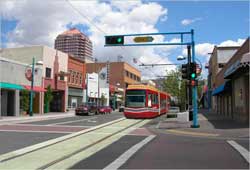Jim Scarantino’s “Trolley Roundabout” column [Re: The Real Side, July 17-23] was full of out-and-out falsehoods.Mr. Scarantino called my Council office, apparently after he had read Dan McKay’s article in the Albuquerque Journal and seen Greg Gurule’s TV report on the modern streetcar cost-benefit report given to the 21 st Century Transportation Task Force (there was no “press conference” or “sneak peek”), to let me know he would be writing his next opinion on the streetcar proposal. I assumed he would be in opposition. Fine. I have no problem with that. What I do have a problem with is Scarantino seems to be utterly uninformed about the issue.Hard-core opponents of the modern streetcar like Scarantino and the Journal , whose line he mimics, love to call it the “trolley” although they know it is a modern vehicle. This helps perpetuate their “tourist toy” characterization. Rather than listen to their hysteria, check out Seattle, Portland or Tacoma to see actual systems in operation. The proposed Albuquerque route compares favorably with those cities’ demographics. In his column, Scarantino asked me to explain “what is so horribly wrong with buses?” I’m a big supporter and rider of our buses, on which we must continue to rely. Unlike the streetcar, buses wear out in 8-12 years, are more expensive to maintain and operate, wear the heck out of our roads, are noisier, dirtier and less comfortable to ride, and use increasingly expensive diesel fuel. A grid-connected, electric, steel-wheeled vehicle can be powered by any future source of electrical generation; as a red herring, Scarantino deliberately associates it with dirty coal. Furthermore, streetcars have the proven ability to spur redevelopment. Buses do not.I’m all for scrutinizing big proposals. Through the entire streetcar debate in 2006, a key criticism was that there had not been a thorough analysis of the project and that people wanted more information. I agreed and so did the City Council. Thus, both the cost-benefit analysis by the Mid-Region Grande Council of Governments (MRCOG) and the Transportation Task Force were authorized. The task force, which I chair in a non-voting capacity, was created in 2007 and is made up of a broad group of representatives who have volunteered their time for the last six months, twice a month, to hear presentations about citywide trails, roadway and transit funding needs, and to make recommendations about the future of the city’s transportation system. Even vocal opponents who attend the meetings would probably attest that I chair them fairly and have never unduly influenced the discussions, though I express my opinion on occasion. Scarantino has never once attended a task force meeting or inquired about the work we’ve been doing over the past six months. Scarantino’s characterization that the Council is considering “raising taxes” without sending the measure to a public vote demonstrates either his ignorance or a lack of interest in encouraging thoughtful discussion. The Council has never proposed a tax increase to fund continued road maintenance, public transit operations or the streetcar. Saying that the Council would be “reneging on the promise that the transportation tax would not become a permanent levy” is also ridiculous. In discussions with my constituents, I have heard overwhelming support for continuing the existing quarter-cent transportation tax. They realize that buses do not operate themselves, and ongoing road maintenance is much more cost effective than having to completely rebuild roads that have been allowed to decay. Scarantino (intentionally or lazily) also mischaracterized what I told Greg Gurule: The task force unanimously recommended extension of the tax. What it is now considering is the allocation between roads, trails and transit, and whether to include the streetcar. I never said the Council or public has already decided this, which he would know to be false if he did his homework.After we were not able to reach each other by phone over the weekend, my office provided Scarantino with a copy of the presentation that was given to the task force, along with a more in-depth explanation of the 5,000 riders-a-day projection. While the entire length of the Route 66 bus serves 9,300 riders a day, the segment that could potentially be replaced by the streetcar from Downtown to San Mateo serves 3,800. The MRCOG estimate of 5,000 riders on the streetcar represents a 24 percent increase over current bus ridership. Annually, this segment of the streetcar alone is projected to see 1,803,760 riders, which is nearly as much as the entire Rapid Ride red line.I provide these figures not to advocate for the streetcar but because the public deserves to be presented with all of the information so they can make an informed decision for themselves. For those who are truly interested in understanding the discussions that the task force has been having that will eventually lead to a report, I invite you to visit the task force’s website ( cabq.gov/council/transportation-task-force), where you can read for yourselves every discussion that has taken place at our meetings. If, like Scarantino, you don’t have the time to read through the meeting minutes and presentation materials, I would ask you to reserve judgment of the task force and its work until a final report and recommendations are complete, which is expected to be by Sept. 1, 2008.
The opinions expressed are solely those of the author. E-mail ibenton@cabq.gov.




